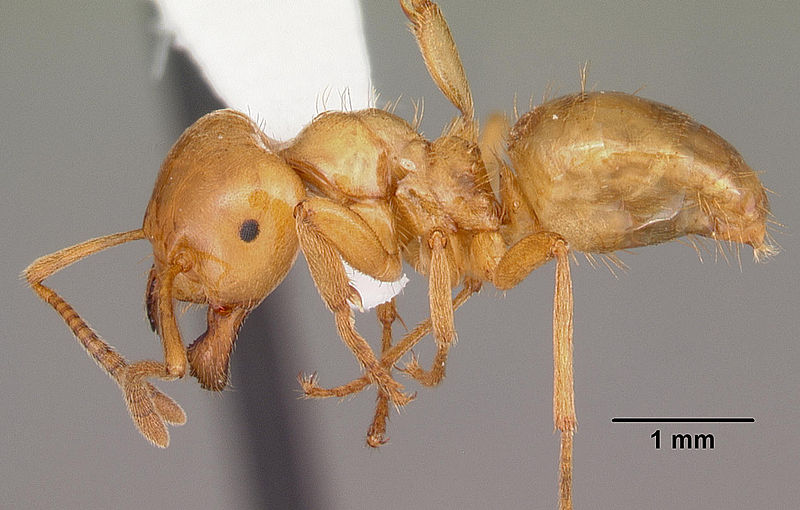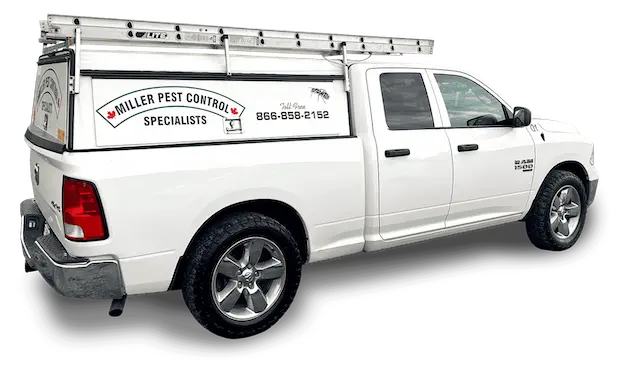Large Yellow Ants
Large yellow ants or citronella ants are not typical invading ants. They generally reside under rocks, wood or other natural “hiding spots”. When disturbed or the colony is damaged, you will usually smell the lemon odour, hence the name of the ant.
If large yellow ants enter a home it is usually just to forage and usually, it is the lower level of the home. If the foundation of the home or cottage is fractured or cracked, the citronella ants will use that as a point of entry.
Treatment consists of using a combination of dust and liquid residual. If they are a reoccurring problem, bait also works well to assist with control. This would be done over several visits.
How to Get Rid of Large Yellow Ants

A full interior and exterior treatment consist of a visual inspection of “hot spot” areas, treatment of cracks and crevices, wall voids, attics, crawl spaces, window and door frames, baseboards, electrical outlets, pipe chases, decking, tree bases and stumps, and perimeter of the structure.
Suggestions will also be made for control measures such as removing overhanging tree limbs, dead tree stumps, sealing gaps and cracks, etc. Treatment can either be a combination of chemical/residual/ULV or bait and dust. Both are equally effective, but bait and dust generally are a little slower to take effect.
A dust treatment for yellow ants requires a minimum of 4 visits, 2 weeks apart from our licensed pest control technicians. If the colony has not been eradicated at the time of treatment, generally within 2 weeks they should be dead.
The treatment is fully warrantied for the season, therefore, if after 2 weeks following treatment there are still signs of ant activity, we will return to repeat the procedure to specific areas or all areas, if necessary.
We recommend all occupants, including pets, vacate the premises for a minimum of 4 hours. Children under 1 year and pregnant women, we recommend 24 hours.
Each year after the initial treatment, Miller Pest Control highly recommends having an exterior preventive treatment. This treatment will help reduce the risk of re-infestation on the interior of the structure and re-guarantees the original interior work.
How to Identify a Large Yellow Ant Infestation
Also known as the citronella ant, Yellow Ants are yellow, or reddish yellow, and emit a lemon scent similar to citronella when crushed. These are sometimes mistaken for termites
- Colour: Yellow-orange hue, often with a citronella or “lemon-like” smell when crushed.
- Size: Approximately 4.5 mm long.
Yellow ants typically leave mounds of soil around their nests. If you find mounds on your property or close to your home you may have an infestation. Many “swarmers” or ants with wings may also indicate that a nest is nearby.
How to Prevent a Large Yellow Ant Infestation
Yellow Ants do not tend to enter homes, however they can build large nests in yards and may cause damage to surrounding plants. Reducing loose vegetation and selective outdoor treatments of insecticide will help deter them from building a nest on your property.
Possible Health Concerns
None. Citronella ants do not pose health concerns or cause structural damage. They are a nuisance and cannot be trapped with baits. The best way to eliminate a citronella ant infestation is with the help of professional pest control services.
About Large Yellow Ants
Large yellow ants are primarily nocturnal and are not generally seen during the day. These ants feed exclusively on the honeydew produced by aphids and mealybugs, with no record of them feeding on household foods. When these ants swarm, they can be mistaken for termites.
Large yellow ants build their nests underground and typically in and around areas of high moisture. Outdoors, they can be found nesting in high moisture soil adjacent to structures, along foundation walls, under stumps, logs, or rocks. Indoors, these ants are sometimes found behind bathtub or shower walls or in damp crawl spaces, especially over winter. Mounds of dirt left behind by the colonies’ process of excavating tunnels can reach up to 1 metre in diameter. Temporary winter nests can be located in basements under a loose brick or board or in a crack in the wall or floor.
Pest problems usually occur in the late summer and fall when mixed colonies of winged swarmers and wingless worker ants move toward buildings and try to enter through cracks or gaps in the foundation.

